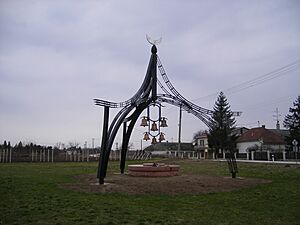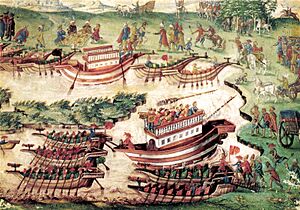Peace of Zsitvatorok facts for kids

Peace of Zsitvatorok Memorial in Radvaň nad Dunajom
|
|
| Type | Peace |
|---|---|
| Signed | 11 November 1606 |
| Location | Zsitvatorok |
| Original signatories |
|
| Parties | |
| Languages | Ottoman Turkish Hungarian |
The Peace of Zsitvatorok (also known as the Treaty of Sitvatorok) was an important peace treaty. It officially ended the 13-year Long Turkish War. This war was fought between the powerful Ottoman Empire and the Habsburg monarchy. The treaty was signed on November 11, 1606. It was also part of a series of agreements that stopped an uprising led by Stephen Bocskai (1604–1606) against the Habsburgs.
Contents
Where the Peace Was Signed
The treaty was discussed and agreed upon between October 24 and November 11, 1606. The meeting happened at a place called ad Situa Torock. This was at the old mouth of the Žitava River. The Žitava River flows into the Danube River. This area was then part of Royal Hungary. Today, it is a small village called Žitavská Tôňa. It is part of the town of Radvaň nad Dunajom in modern-day Slovakia.
What the Treaty Said
The peace agreement was set to last for 20 years. However, people have understood it in different ways over time. This is because the Ottoman Turkish and Hungarian versions of the treaty were not exactly the same.
For example, the Hungarians offered a one-time payment of 200,000 florins. This was instead of the yearly payments of 30,000 guldens they had given before the war. But the Ottoman text suggested that this payment would need to be repeated every three years.
The treaty also tried to stop Ottoman raiding parties from attacking Royal Hungary. It said that Hungarian towns under Ottoman rule could collect their own taxes. They would do this using their own village judges. The Ottomans also agreed that nobles would not have to pay taxes. However, the Ottomans often did not follow these rules.
Who Signed and What Happened Next
Sultan Ahmed I signed the treaty for the Ottoman Empire. Archduke Matthias of Austria signed for the Holy Roman Empire. Matthias's brother, Emperor Rudolf II, officially approved the treaty on December 9.
The Long Turkish War showed that the Ottomans could not push further into Habsburg lands. This was one of their first big defeats in terms of controlling more territory. Still, the treaty helped bring peace to the border between the Habsburgs and Ottomans for about 50 years. This was good for both sides. The Habsburgs had problems at home to deal with. The Ottomans also faced rebellions and fought wars with other countries like Poland and Iran.
A New Level of Respect
At Zsitvatorok, something very important happened for the first time. The Ottoman Sultan had always called himself Kayser-i Rûm. This meant "Caesar of the Roman Empire." He had used this title since the Fall of Constantinople. But in this treaty, he recognized the Holy Roman Emperor as his equal. He called the Emperor Padishah. This was the Sultan's own special title, meaning "Emperor" or "Master King."
This was a big deal. It meant that the two empires agreed to share power. The Holy Roman Empire would be the main power in the West. The Ottoman Empire would be the main power in the East. Before this, Ottoman leaders had only called the Holy Roman Emperor the "king" of Vienna. The next European ruler to be given this same level of respect was Catherine the Great of Russia. This happened much later, in the Treaty of Küçük Kaynarca in 1774.
The treaty also clearly stated that the Crimean Khanate was a vassal (a state that owes loyalty) of the Ottoman Empire.


